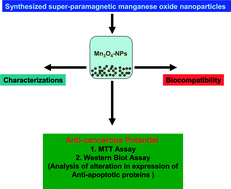In vitro evaluation of anticancer and biological activities of synthesized manganese oxide nanoparticles†
Abstract
This paper presents the results from a systematic study into the characterization and anticancer and biological activity of synthesized super-paramagnetic manganese oxide nanoparticles (Mn3O4-NPs). The Mn3O4-NPs showed an IC50 value of 666.44 μg mL−1 on the HT29 human colorectal cell line. Furthermore, we investigated the molecular mechanism of Mn3O4-NPs for the inhibition of Bcl-2 and Bcl-xL through an in vitro study. Bcl-2 and Bcl-xL are key signaling regulators of the programmed cell death pathway and ensure proper apoptosis and have been proposed as a novel target for anticancer therapy. The down-regulation of Bcl-2 and Bcl-xL on the HT29 cancer cell line showed that the NPs under study could be useful in the treatment of cancer. The down-regulation of the anti-apoptotic regulators Bcl-2 and Bcl-xL enhances cytotoxicity in colon carcinoma cells connected with the induction of apoptosis. Moreover, the in vitro haemolysis study antibacterial tests showed that Mn3O4-NPs have no significant toxicity and antibacterial activity, thereby exhibiting their biocompatibility and reliability in biomedical sciences.


 Please wait while we load your content...
Please wait while we load your content...